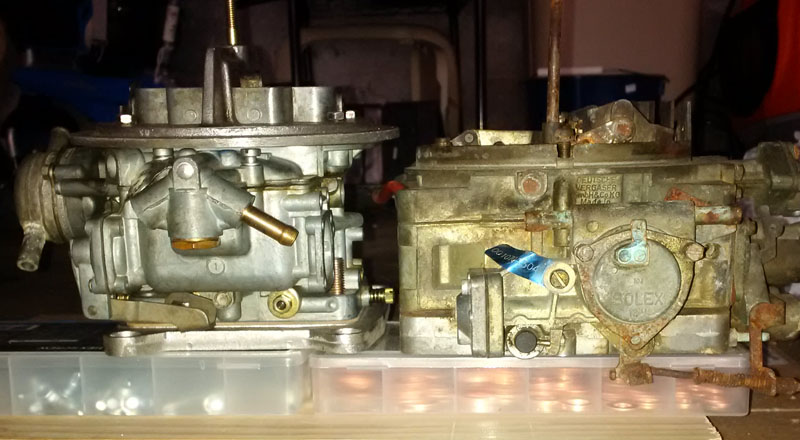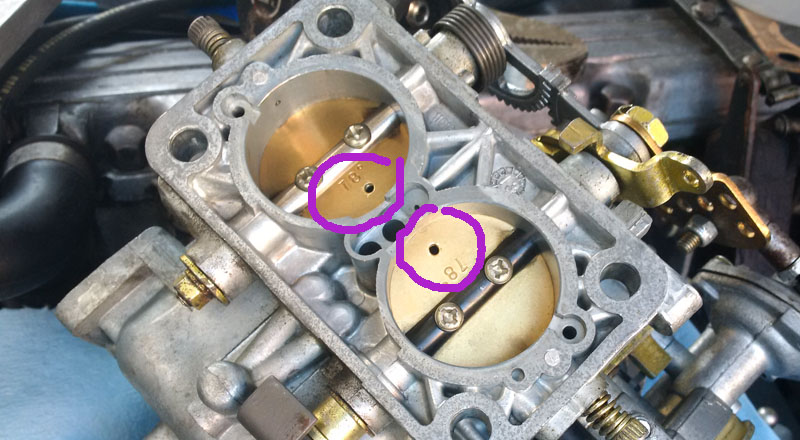 |
| Home |
Difference between Solex 4a1 and Weber 38 carburetor
Weber carburetor is a popular replacement for malfunctioning Solex carbs. The carb has a great racing pedigree and because it’s endlessly customizable it is a decent substitute, but… Yes, here is the but. Before deciding on the swap understand that Solex IS a better match for your car for many reasons I’ll outline below. Those two are different carbs that also have different characteristics. By replacing your Solex you are trading some pros (and cones) for a different sort of pros and cons. Physically Weber is a 2-barrel carb while Solex has 4. Solex "saves" you money on gas by operating on its small primary barrels only kicking in the secondaries when the engine needs it. Solex is about 3/4 inch shorter so the closed hood doesn’t rest on the air filter. Moreover Solex has throttle lift dashpot that stabilizes your idle when the engine needs more power running AC for example. Now your Solex might have been molested over years by many untrained “mechanics” and it might have developed warpage that might be hard to fix, so spending a few hundred dollars for a brand new Weber carb might be enticing but understand that the conversion from Solex to Weber is NOT bolt-on simple. You WILL have to modify some aspects of the plate, linkage and the carb... So maybe it's better to just rejuvenate the old Solex? So what are the problmes with the swap? Straight from the box Weber will NOT idle on M110 engine because the engine needs a bit more air to breath. On Solex you have air bypass screws (the untouchable screws at the base of the secondaries) while Weber does not. You try to get the carb to idle just enough so you can set the mixture screws but it doesn't let you without screwing in the speed screw - thus upsetting your adjustments. The solution is to drill holes in the throttle plates of the Weber carb (on mine they are 2.3mm in diameter) as a sort of simple air bypass that’s found on some other carbs - and you thought it was going to be simple...
This action let you idle at a decent enough RPM that you can close the throttle plates so that transition holes are not exposed (VERY important) to set the idle properly. When the car idles OK with the transition holes not exposed and holes in throttle plates, you can start tuning. Most likely you will have to bump up the idle jets to 65 or even 70. They are easy to get to – you just unscrew side screws on side of the carb. This should up your idle to around 850-900 RPM in P. The problem is that we don’t idle that often in P rather in D, so it’s important to check the RPM in D. On mine, when switching from P to D, the RPM drops by around 300. So from acceptable 850 it goes down to 550, which on M110 engine is simply too low. The solution is to open up speed screw (thus exposing transition holes – which is kinda OK because by now you have set your mixture screw properly BUT getting sluggish acceleration as transitions holes are not really doing their jobs anymore). Weber has a nipple for fuel bowl vent but the instructions that come from Redline don't specify what to do with it. Well, if you have the plumbing, connect it where your Solex was venting, if not, then just cap the nipple. Solex has an easy way to control the choke pull off with a screw. On Weber, the screw is capped so if you are unhappy with the choke pull off - you need to uncap it. If you need to remove air horn, this operation is much easier on Solex because the choke is held with a spring wire while on Weber you are dealing with a tiny c-clip. Removal of air horn gives you access to fuel bowl - again on Solex you can right away see the fuel level while on Weber you must guess because to set the fuel level you need to set the air horn at 90 degrees as the float is attached to it. Adjustment of accelerator pump is much easier on Solex with simple screw. But what does complicates Solex are its secondaries and need to set the air flap tension by ear of the engine as you drive it (there is a weight recommended in the manual but it's pretty much useless in real application). The above is just a short summary but I hope it shows you that a "simple" solution of just getting a new Weber is not as straight forward as putting down the money to buy something really is. The fact that vast majority of mechanics aren't experienced in carburetors anymore leaves you stranded with seeking your own answers but unfortunately the internet is littered with he-said-she-said garbage and it's actually very hard to find solutions. |
| copyright 2019 by Patryk Rebisz |

